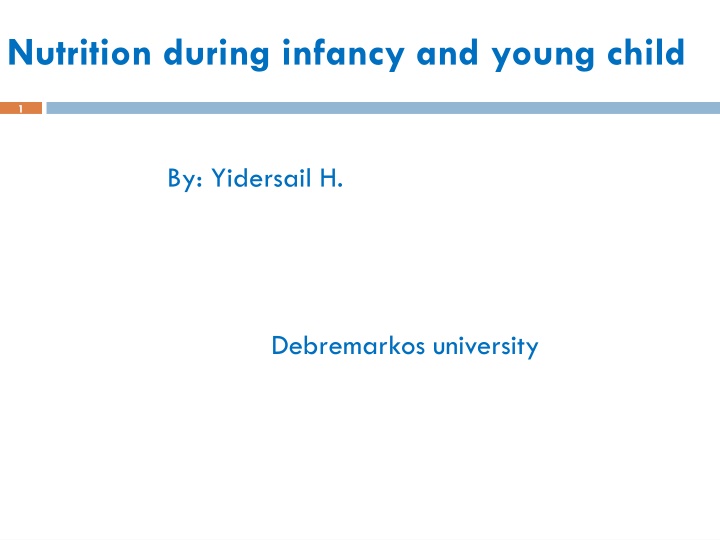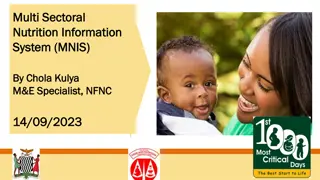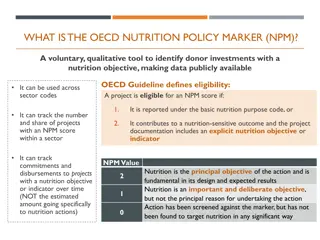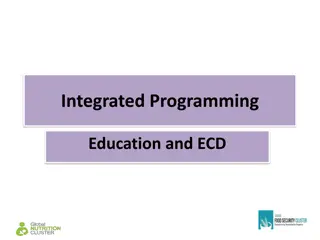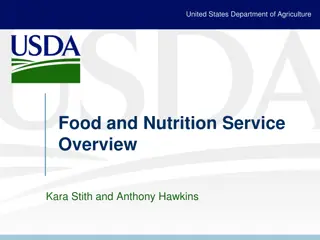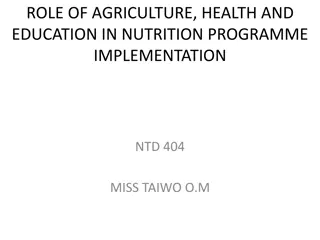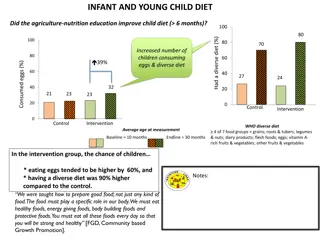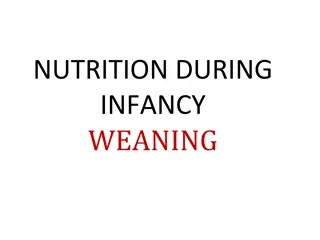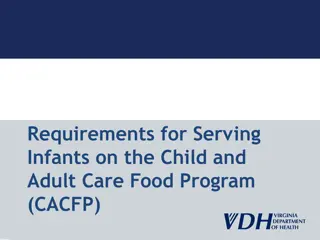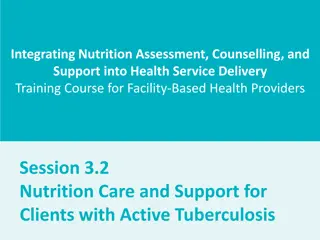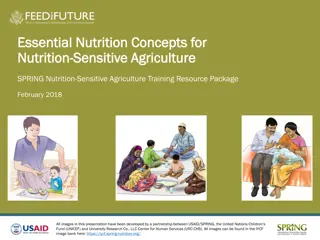Infant Nutrition and Growth Development Overview
This informative content covers various aspects of infant nutrition and growth development, including breastfeeding, complementary feeding, and common nutritional problems. It also discusses assignments related to assessing nutritional status, harmful traditional practices, and the importance of neonatal nutrition. The content emphasizes the significance of proper nutrition during infancy for optimal growth and development.
Download Presentation

Please find below an Image/Link to download the presentation.
The content on the website is provided AS IS for your information and personal use only. It may not be sold, licensed, or shared on other websites without obtaining consent from the author.If you encounter any issues during the download, it is possible that the publisher has removed the file from their server.
You are allowed to download the files provided on this website for personal or commercial use, subject to the condition that they are used lawfully. All files are the property of their respective owners.
The content on the website is provided AS IS for your information and personal use only. It may not be sold, licensed, or shared on other websites without obtaining consent from the author.
E N D
Presentation Transcript
Nutrition during infancy and young child 1 By: Yidersail H. Debremarkos university
Contents 2 Growth and development infant and young child feeding Breast feeding Complementary feeding infant feeding on the occasion of HIV/AIDS
Assignments 3 G1.1.The role of baby friendly hospital initiatives on reduction of under nutrition during perinatal periods. 2. Assess the nutritional status of pregnant women and assess the feeding habits of 15 women at Debre Markos HC. G3. 1. Birth defects related to nutrition metabolism errors 2. assess the nutritional status of infants and assess the feeding habits of 15 infants at Wuseta HC. G4.1. Harmful traditional practices that influence maternal and child feedings. 2. assess the nutritional status of children age less than five years for at least 20 children at Hidase health center 4. 1. Common Nutritional Problems and Concerns infant and children 2. assess the nutritional status of pregnant women and assess the feeding habits of 15 women at Gozamin HC.
Infant growth an development 4 Neonates Neonatal Nutrition is important to meet the metabolic requirements of developing organ systems, satisfy normal growth requirements and The Nutritional requirements of the term neonate differ from those of the preterm neonate(<37 weeks ) Preterm babies doesn t have enough nutrient store so they need supplement Neonates need 100 120 (cal/ kg/d) in order to grow properly
Infant growth an development 5 Infancy is a period a from birth to the end of the first year of life. Full-Term Infants -Infants born between 37 and 42 weeks of gestation. Preterm Infants- Infants born before 37 weeks of gestation. Infant Mortality Death that occurs within the first year of life. Infancy is a time of rapid growth for the body, physiological and mental development.
Infant growth an development 6 Normal growth and development is characterized by a regulated increase in the size, mass and complexity of function of tissues and organs. Infants grow and develop rapidly in the first two years, ma7/16/2024king them particularly vulnerable to nutritional inadequacies energy intake utilized for growth is highest in the first 3 months after birth. Infant feeding is the feeding of a child from birth to one year of age.
8 Growth and dev t accompanied by a number of physiological changes which include. Change in body size: A healthy normal infant doubles its birth weight by six months Triples the birth weight by the end of one year. The infant grows approximately 25 cm by the end of the first year.
Cont. 9 Change in body composition Weight gain comprises of growth in muscles, organ tissue, skeletal tissue and skeletal structure At birth infants water content as high as 75 % and 12-15 %fat At the end 1year the water content decreases to 60 %and fat content increases to 24 % 4 to 6 months, almost 1/3 of the infant s energy requirement is used for growth.
10 Changes in gastro intestinal system: New born is able to digest simple proteins, emulsified fat and simple carbohydrates At the end of first year the child is able to digest all types of food. Mental development Rapid increase in the number of brain cells in the first 5-6 months after birth then decline.
11 Feeding behavior At birth the baby is able to coordinate sucking, swallowing and breathing At 6 months chewing movements develops
Nutrient Requirement of infant 13 Requirements for macronutrients and micronutrients are higher on a per kilogram basis during infancy and childhood than at any other developmental stage Energy The caloric needs of typical infants are higher per body weight than at any other time of life infants require 108 k.cal/kg and 98 k.cal/kg during 0-6 months and 6-12 months of age respectively After 6 months 60- 80 % of energy requirement is met by breast milk and for the rest supplementary foods have to be given
Cont. 14 Protein Recommended protein intake from birth up to 6 months averages 2.2 g of protein per kg of body weight Human milk provides all the amino acids essential for proper growth. After six months the protein requirement is 1.6 g/kg body weight.
Cont. 15 Fat 30 g/day of fat Requirements for fatty acids on a per kilogram basis are higher in infants than adults Fat restriction is not recommended. Breast milk provides 55% of its calories from fat, and this percentage reflects an adequate intake of fat by infant Breast milk contains short-chain and medium-chain fatty acids (in addition to the long-chain) easier to digest and utilize than long-chain fatty acids
Cont. 16 Vitamins and minerals The vitamin and mineral needs of children increase with age A balanced diet of nutritious foods can meet children s needs for these nutrients With the exception of vitamin D, the vitamins in breast milk are ample to support infant growth The calcium content of breast milk is ideal for infant bone growth, and the calcium is well absorbed Breast milk contains relatively small amounts of iron, but the iron has a high bioavailability Zinc also has a high bioavailability, due to the presence of a zinc-binding protein
Cont. 17 Vitamins A 350 mg per day throughout infancy is recommended Vitamin K injection given at birth Prevent hemorrhagic disease , since the infant intestine is sterile ,it is free from bacteria that produce vitamin k . Vitamin D Vitamin D, is required for bone mineralization with calcium. recommended level of 400 IU per day. Calcium Breast fed infant receive 300mg of calcium daily Iron 1mg / kg body weight/day for an infant is recommended Needed for growth, expansion of blood volume and for improving iron stores in the body infants born with good iron stores sufficient to last for 4-6 months
Con 18 B complex vitamins and vitamin C breast fed infants derive the required B complex vitamin requirements from breast milk 25mg of vitamin C per day Vitamin C have effect on non-haemiron absorption
Optimal Infant and Young Child Feeding (IYCF) 19 IYCF, refers to nutrition and care techniques that improve child survival and growth. Adequate nutrition during infancy and early childhood is essential to ensure the growth, health, and development of children to their full potential It is estimated that sub-optimal breastfeeding, especially non-exclusive breastfeeding in the first 6 months of life, results in 1.4 million deaths and 10% of the disease burden in children younger than 5 years
BREAST FEEDING 21 Mothers should exclusively breastfeed their infants for the first 6 months of life and thereafter, continue breastfeeding up to 24 months or beyond Exclusively breastfeeding- giving no other food or drink not even water except breast milk(WHO). Drops or syrups consisting of vitamins, mineral supplements or medicines are permitted
IYCF PRACTICE CON. 22 Advantages of breast feeding to the infant Human breast milk perfectly meets the needs of infants Is a whole food for the infant, and covers all babies needs for the first 6 months. Is always clean. The infant benefits from the colostrum, which protects him/her from Long-term benefits of breastfeeding include reduced risk of obesity and diabetes
Advantages of breast feeding to the infant 23 Is always ready. Is easy to digest and Nutrients are well absorbed. Contains enough water for the baby s needs. Infants are at lesser risk of food allergy Psychological importance :- create a healthy, happy and emotional relationship between the mother and the infant.
Cont.. 24 It contains digestive enzymes such as amylase and lipase Supplies growth factors that combine to mature the infant gut. Provides the infant with immune factors necessary to fight illnesses Breast milk contains immunologic substances such as IgA, lactoferrin, lysozymes, macrophages
Importance of breastfeeding for the mother 25 Breastfeeding is more than 98% effective as a contraceptive method during the first 6 months if the mother is exclusively breastfeeding, day and night and if her menses/period has not returned. BM immediately after birth facilitates the expulsion of placenta Breastfeeding reduces the risk of bleeding after delivery. When the baby is immediately breastfed after birth, breast milk production is stimulated
Cont. 26 Immediate and frequent suckling prevents engorgement. Breastfeeding reduces the mother s workload. Breast milk is available at anytime and anywhere, is always clean, nutritious and at the right temperature. Breastfeeding is economical: formula costs a lot of money, and the non-breastfed baby or mixed-fed baby is sick much more often, which brings costs for health care. Breastfeeding reduces risks of breast and ovarian cancer.
Importance of breastfeeding for the community/nation 27 Healthy babies make a healthy nation. Savings are made in health care delivery Improves child survival because breastfeeding reduces child morbidity and mortality. Protects the environment Breast milk is a natural renewable resource. Not importing milks and utensils necessary for the preparation of these milks saves money that could be used for something else.
Optimum breast feeding 30 1. Initiate breastfeeding immediately 2. Give colostrum Colostrum is th3 times richer in vitamin A and ten times richer in beta-carotene than mature milk baby s first immunization. 3. Practice exclusive breastfeeding from 0-6 months 4. Breast feed the baby on demand 5. good attachment and positioning
Facts for Feeding 0-6 months 31 1.Initiate breastfeeding within 1 hour of birth Serves as babies first immunization Reduces risk of postpartum hemorrhage Fosters mother-child bonding Stimulates breast milk production
Facts for Feeding 0-6 months 32 2. provision of colostrum . Establish good breastfeeding practices Proper positioning Proper attachment Observe signs of effective feeding No bottles Suckling increases breast milk production
Facts for Feeding 0-6 months 33 3. Breastfeed exclusively for first six months Do not give pre-lacteal feeds (e.g. liquids or foods) Do not give water Offering foods before 6 months can reduce BM production
Facts for Feeding 0-6 months 34 4. Practice frequent, on-demand breastfeeding, including night feeds 12 times a day -- every 2 hours or more if needed -- especially in early months Frequent feedings maintain mother s milk supply, maximize contraceptive effects and provide immune factors at each feeding. Frequent feeding avoids problems such as breast engorgement that can lead to mastitis Empty one breast before giving the other Adequacy of breastfeeds shown by baby urinating at least 6 times in 24 hours
Facts for Feeding 0-6 months 35 5. Feeding during and after illness During illness: breastfeed more frequently limit the weight loss. After illness: continue to breastfeed more frequently If infant too sick to suckle, then express breast milk and give with a cup & spoon, speed recovery 6. Feeding when mother is away or sick Mother should express breast milk into clean container Breast milk should be stored in clean covered container; 8-10 hours at room temperature in cool place or 72 hours in a refrigerator Caregiver feeds expressed breast milk from cup using spoon Never use a bottle?
Facts for Feeding 0-6 months 36 BARRIERS TO BREAST FEEDING Belief that breast milk is not sufficient lack of adequate support system breast engorgement, cracked nipple, sore nipple chronic illness in mother ,psychosis , cancer
Complimentary feeding 37 At 6 months of age: Breast milk alone does not provide sufficient calories & nutrients to sustain optimal growth; complementary feeding becomes necessary to fill the energy and nutrient gap Infants are developmentally ready to take soft, and semi- soft foods in addition to breast milk
Cont. 38 If complementary foods are not introduced at this age or if they are given inappropriately, an infant s growth may falter. In many countries, the period of complementary feeding from 6 23 months is the time of peak incidence of growth faltering, micronutrient deficiencies and infectious illnesses.
Complementary foods should be: 39 Timely -CFs are introduced at six months of age. Adequate provide sufficient energy, protein and micronutrients to meet a growing child s nutritional needs Safe hygienically stored and prepared and fed with clean hands using clean utensils and not bottles and teats Properly fed meaning that they are given consistent with a child s signals of hunger and that meal frequency and feeding methods are suitable for the child s age.
Cont. 40 Too Late CF introduction Too Early CF introduction diarrheal disease & risk of dehydration decreased breast-milk production Allergic sensitization developmental concerns potential growth failure iron deficiency developmental concerns
Cont. 41 Between 6 and 12 months breast milk generally provides up to half or more of an infant s nutritional requirements between 12 and 24 months, up to one-third of requirements
Guiding principles for CF of the breastfed child 42 1.Practice exclusive breastfeeding from birth to 6 months of age, and introduce CF at 6 months of age (180 days). 2. Continue frequent, on-demand BF until 2 yrs of age or beyond. 3. Practice responsive feeding. 4. Practice good hygiene and proper food handling. 5. Start at 6 months of age with small amounts of food & increase the quantity as the child gets older, while maintaining frequent BF.
Cont. 43 6. Gradually increase food consistency and variety as the infant grows older 7. Feed a variety of nutrient-rich foods to ensure that all nutrient needs are met. 9. Use fortified CF or vitamin-mineral supplements for the infant, as needed 10. Increase fluid intake during illness, more frequent breastfeeding
IYCF cont.. 44 RECOMMENDATIONS 1. Maintain breastfeeding up to two years of age along with complimentary feeding 2. Practice responsive feeding Feed infants directly and assist older children when they feed themselves. Feed slowly & patiently, encourage to eat, but don t force them, talk to children during feeding with eye-to-eye contact. If children refuse many foods, try with different food combinations, tastes, textures and methods of encouragement. Minimize distractions during meals if they lose interest easily.. 3. Complementary foods should be safely prepared and stored
Cont. 45 4. Amount of food should be adequate for child s age Introduce small amounts of food at 6 months and increase the quantity, as the child gets older, while maintaining frequent breastfeeding 5. Ensure appropriate food consistency by 6 months: pureed, mashed and semi-solid foods by 8 months: finger foods & snacks by 12 months: family foods 6. Ensure meal frequency and energy density As child gets older, increase the number of times that the child is fed complementary foods
Cont. 46 Average healthy breastfed infant, need: 2-3 meals per day at 6-8 months 3-4 meals per day at 9-11 months 4 meals per day at 12-24 months Offer snacks 1-2 times per day
Cont. 47 7. Ensure adequate nutrient content of complementary foods Feed a variety of foods (micronutrients) Meat, poultry, fish or eggs as often as possible Vitamin A-rich fruits and vegetables daily Provide diets with adequate fat content Avoid giving drinks with low nutrient value, 8. Vitamin-mineral supplements or fortified products be used by the infant and mother when needed
Cont. 48 9. Continue feeding during illness and feed more after illness During illness increase fluid intake including more frequent breastfeeding, and encourage the child to eat soft, varied foods After illness give food more often than usual and encourage the child to eat more After illness, increased nutrient intake is needed to compensate for losses & allow for catch-up growth
updated IYCF indicators 49 8 Core Indicators: 1.Early initiation of breastfeeding(Proportion of children born in the last 24 months who were put to the breast within one hour of birth). Exclusive breastfeeding for 6 months(Proportion of infants aged 0-5 months who are fed exclusively with breast milk) 2. Continued breastfeeding at 1 year (proportion of infants aged 12-15 months who are fed breast milk) 3.
IYCF indicators cond 50 4. Introduction of solid, semi-solid or soft foods(proportion of infants aged 6-8 months who receive solid, semi-solid or soft foods) 5. Minimum dietary diversity (Proportion of children 6-23 months of age who receive foods from 4 or more food groups 6. Minimum meal frequency (Proportion of breastfed and non-breastfed children 6-23 months of age who receive solid, semi-solid, or soft foods the minimum number of times or more: 2 for 6-8 mo., 3 for 9-23 mo., 4 for 6-23 mo.)
Cont. 51 7. Minimum acceptable diet (Proportion of children 6-23 months of age who had both minimum meal frequency and dietary diversity) 8. Consumption of iron-rich or iron-fortified foods
Cont. 52 Optional indicators 9. Children ever breastfed 10. Continued breastfeeding at 2 years 11. Age-appropriate breastfeeding 12. Predominant breastfeeding under 6 months 13. Duration of breastfeeding 14. Bottle feeding 15. Milk feeding frequency for non-breastfed children
cont. 53 The 7 food groups include the following: 1. Grains, roots and tubers 2. Legumes and nuts 3. Dairy products (milk, yoghurt, cheese) 4. Flesh foods (meat, fish, poultry, and liver/organ meats) 5. Eggs 6. Vitamin A rich fruits and vegetables 7. Other fruits and vegetables
CHILD FEEDING AND HIV/AIDS 56 Children living with HIV/AIDS are at great risk of malnutrition. HIV/AIDS stunts child growth and can reduce appetite, food intake, and nutrient absorption at a time when the body needs good nutrition the most to fight the infection. weakened immune system unable to fight the virus and infections like tuberculosis. Many HIV-positive children suffer from severe acute malnutrition, a life-threatening condition. To increase their chances of survival, these children need therapeutic foods to urgently treat malnutrition, antiretroviral treatment to stop the disease from progressing.
Cont. 57 All HIV cases require 10% more energy when asymptomatic 20 30% more when symptomatic. Children who are experiencing weight loss need between 50% and 100% more energy every day HIV can be passed from a mother to her infant during pregnancy, during labour and delivery, and through breastfeeding
